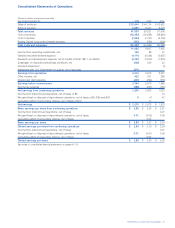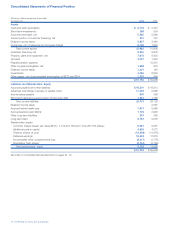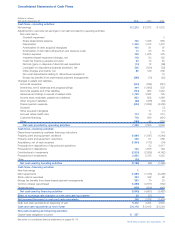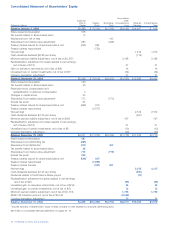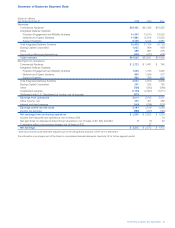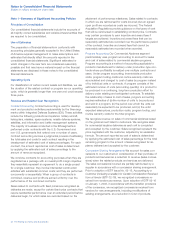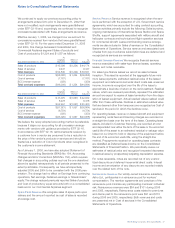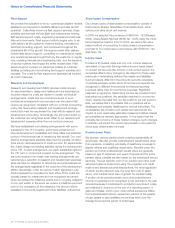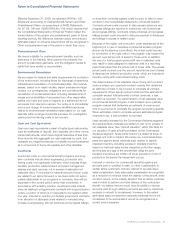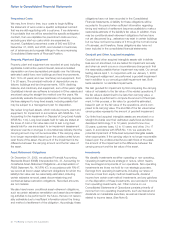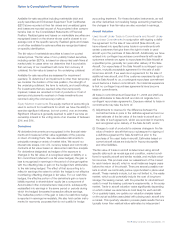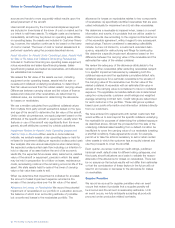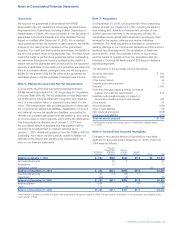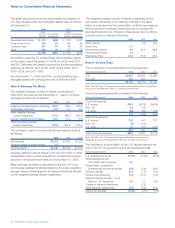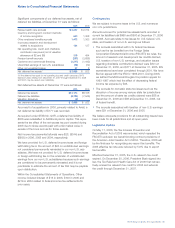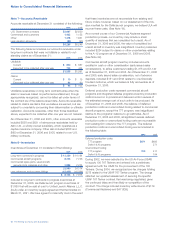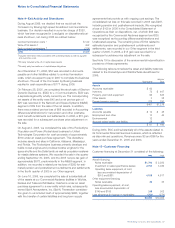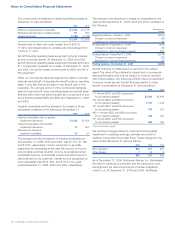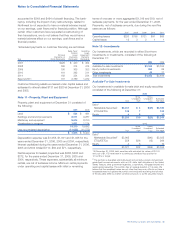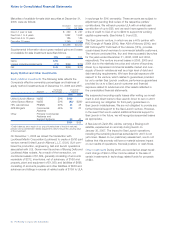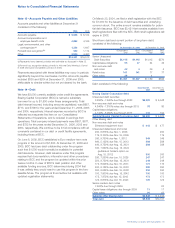Boeing 2006 Annual Report Download - page 53
Download and view the complete annual report
Please find page 53 of the 2006 Boeing annual report below. You can navigate through the pages in the report by either clicking on the pages listed below, or by using the keyword search tool below to find specific information within the annual report.The Boeing Company and Subsidiaries 51
Notes to Consolidated Financial Statements
Available-for-sale securities including marketable debt and
equity securities and Enhanced Equipment Trust Certificates
(EETCs) are recorded at their fair values and unrealized gains
and losses are reported as part of Accumulated other compre-
hensive loss on the Consolidated Statements of Financial
Position. Realized gains and losses on marketable securities are
recognized based on the shares whose cost is closest to our
average cost of the specific security. Realized gains and losses
on all other available-for-sale securities are recognized based
on specific identification.
The fair value of marketable securities is based on quoted
market prices. The fair value of non-publicly traded securities,
including certain EETCs, is based on discounted cash flows at
market yield. In cases when we determine that it is probable
that recovery of our investment will come from recovery of
collateral, the fair value is based on the underlying collateral.
Available-for-sale securities are assessed for impairment
quarterly. To determine if an impairment is other than temporary,
we consider the duration of the loss position, the strength of
the underlying collateral, the term to maturity, and credit ratings.
For investments that are deemed other-than-temporarily
impaired, losses are recorded in Cost of products or Cost of
services and payments received on these investments are
recorded using the cost recovery method.
Equity Method Investments The equity method of accounting is
used to account for investments for which we have the ability to
exercise significant influence, but not control, over an investee.
Significant influence is generally deemed to exist if we have an
ownership interest in the voting stock of an investee of between
20% and 50%.
Derivatives
All derivative instruments are recognized in the financial state-
ments and measured at fair value regardless of the purpose
or intent of holding them. We use derivative instruments to
principally manage a variety of market risks. We record our
interest rate swaps, non-U.S. currency swaps and commodity
contracts at fair value based on discounted cash flow analysis.
For derivatives designated as hedges of the exposure to
changes in the fair value of a recognized asset or liability or a
firm commitment (referred to as fair value hedges), the gain or
loss is recognized in earnings in the period of change together
with the offsetting loss or gain on the hedged item attributable
to the risk being hedged. The effect of that accounting is to
reflect in earnings the extent to which the hedge is not effective
in achieving offsetting changes in fair value. For our cash flow
hedges, the effective portion of the derivative’s gain or loss is
initially reported in shareholders’ equity (as a component of
Accumulated other comprehensive loss) and is, subsequently,
reclassified into earnings in the same period or periods during
which the hedged forecasted transaction affects earnings.
The ineffective portion of the gain or loss of a cash flow hedge
is reported in earnings immediately. We also hold certain instru-
ments for economic purposes that do not qualify for hedge
accounting treatment. For these derivative instruments, as well
as other derivatives not receiving hedge accounting treatment,
the changes in their fair value are also recorded in earnings.
Aircraft Valuation
Used Aircraft Under Trade-in Commitments and Aircraft Under
Repurchase Commitments In conjunction with signing a defini-
tive agreement for the sale of new aircraft (Sale Aircraft), we
have entered into specified-price trade-in commitments with
certain customers that give them the right to trade in used
aircraft upon the purchase of Sale Aircraft. Additionally, we have
entered into contingent repurchase commitments with certain
customers wherein we agree to repurchase the Sale Aircraft at
a specified price, generally ten years after delivery of the Sale
Aircraft. Our repurchase of the Sale Aircraft is contingent upon
a future, mutually acceptable agreement for the sale of addi-
tional new aircraft. If we execute an agreement for the sale of
additional new aircraft, and if the customer exercises its right to
sell the Sale Aircraft to us, a contingent repurchase commitment
would become a trade-in commitment. Our historical experience
is that no contingent repurchase agreements have become
trade-in commitments.
All trade-in commitments at December 31, 2006 and 2005 are
solely attributable to Sale Aircraft and did not originate from
contingent repurchase agreements. Exposure related to trade-in
commitments may take the form of:
(1) Adjustments to revenue for the difference between the
contractual trade-in price in the definitive agreement and our
best estimate of the fair value of the trade-in aircraft as of
the date of such agreement, which are recorded in Inventory
and recognized upon delivery of the Sale Aircraft, and/or
(2) Charges to cost of products for adverse changes in the fair
value of trade-in aircraft that occur subsequent to signing of
a definitive agreement for Sale Aircraft but prior to the
purchase of the used trade-in aircraft. Estimates based on
current aircraft values are included in Accounts payable
and other liabilities.
The fair value of trade-in aircraft is determined using aircraft
specific data such as model age and condition, market condi-
tions for specific aircraft and similar models, and multiple valua-
tion sources. This process uses our assessment of the market
for each trade-in aircraft, which in most instances begins years
before the return of the aircraft. There are several possible mar-
kets in which we continually pursue opportunities to place used
aircraft. These markets include, but are not limited to, the resale
market, which could potentially include the cost of long-term
storage; the leasing market, with the potential for refurbishment
costs to meet the leasing customer’s requirements; or the scrap
market. Trade-in aircraft valuation varies significantly depending
on which market we determine is most likely for each aircraft.
On a quarterly basis, we update our valuation analysis based
on the actual activities associated with placing each aircraft into
a market. This quarterly valuation process yields results that are
typically lower than residual value estimates by independent


